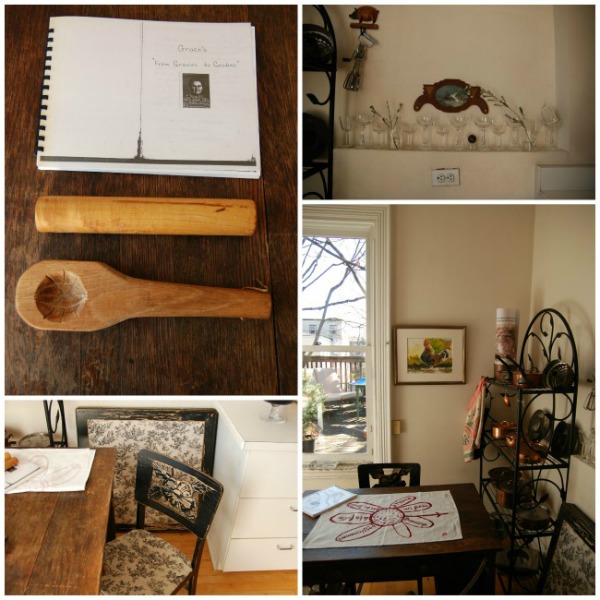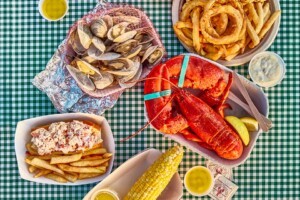The Kitchen Spy: Inside the Food Nerd World of Bondir's Jason Bond
 All photos by Charlotte Wilder for Boston magazine
All photos by Charlotte Wilder for Boston magazine
A visit to Bondir chef Jason Bond’s condo is a lesson in food history—it’s decked out with antique tools, countless history books, and generations of family recipes. The condo also may appear incredibly familiar, if you’ve ever dined at Bondir; many of the dishes, pots, and even artwork comes straight from Bond’s abode, which he shares with his wife Monica. Herewith, a peek into his rare books, quirky gadgets, and lots of other food nerdery.
Clockwise from top left: 1.-2. Recognize the plates on the top right shelf? You’ll also find them at Bondir. Most of the glasses, mugs, and plates here were sourced from antique shops on Charles Street during the years that Bond worked at No. 9 Park and Beacon Hill Bistro. On the right of the center shelf is Hu Kwa, a type of smoked black tea that Bond likens to Lapsang Souchong. Bond uses copper pots (above the top shelf) that he’s scored in antique stores and auctions at his restaurant, and he keeps the smaller, lighter ones in his kitchen for heating sauces or broths. 3.-4.The book on the bottom left is Beeton’s Household Management by Isabella Beeton. “It’s an old turn of the century cookbook. [Beeton] was young, probably in her early 20’s, and this book is intense,” Bond says. “It’s a really amazingly thorough cookbook for someone as young as she was.”
 Clockwise from top left: 1. A scanned copy of his grandmother’s bound recipe collection, called “Grace’s, from Gravies to Goodies,” along with her rolling pin. Below these is a tool that was used by his other grandmother to make M’amoul, a type of stuffed Arabic cookie. 2. Monica, has a collection of her mother’s cordial glasses. “I always feel more fancy having some champagne out of a glass like that,” she says. 3. The watercolor on the wall was painted by Bond’s grandfather. “That was a pet rooster that they had when my mom was a little girl, named Roostie,” Bond says. “I guess he was just like a dog, and followed them around and played in the river [in Illinois].” 4. An antique matching Trompe L’oeil folding card table and chair set that Bond picked up in New Hampshire.
Clockwise from top left: 1. A scanned copy of his grandmother’s bound recipe collection, called “Grace’s, from Gravies to Goodies,” along with her rolling pin. Below these is a tool that was used by his other grandmother to make M’amoul, a type of stuffed Arabic cookie. 2. Monica, has a collection of her mother’s cordial glasses. “I always feel more fancy having some champagne out of a glass like that,” she says. 3. The watercolor on the wall was painted by Bond’s grandfather. “That was a pet rooster that they had when my mom was a little girl, named Roostie,” Bond says. “I guess he was just like a dog, and followed them around and played in the river [in Illinois].” 4. An antique matching Trompe L’oeil folding card table and chair set that Bond picked up in New Hampshire.
Clockwise from top left: 1. Bond sources lots of housewares and colorful pots from the shop Abodeon in Porter Square. 2. Bond got this miniature, round La Cocotte Staub cocotte after a visit to the company’s headquarters in Alsace. 3. Several of Bond’s serious butchery knives. Fourth from the top of the tray is a larding needle, which “is used for all kinds of things, most simply for larding a piece of meat with pieces of fat or pieces of truffle,” Bond says. “It’s also nice for stuffing a whole suckling pig or something. It’s got a really sharp needle, so you can just poke holes through it and tie [up the pig] almost like you were tying a shoe.” 4. An assortment of old-school Peugot pepper grinders, and a cutting board that’s a memento of Bond’s time cooking at the Museum of Fine Arts; it’s a slice of an old table that was tossed during renovations.
Clockwise from top left: The contents of Bond’s fridge are sparse but serious. In the green cloth on the lower shelf is lardo, from a Mangalitsa pig that Bond raised a couple of years ago. Above that is a platter of charcuterie, left over from a seminar with Austrian Mangalitsa pig farmers that Bond attended in New Jersey. In the door of the fridge, you’ll find lots of preserved, sweet condiments like homemade dulce de leche, choke cherry jelly from Bond’s aunt, and rhubarb jam from a friend. In the freezer? Two essentials: his mother’s fruitcake, and bags of grits.
Bond stores even more jars of preserves, like prunes in Armagnac brandy, green tomato picalilli (from one of his former pastry chefs), and choke cherry and wild plum jams from an aunt in South Dakota.
Clockwise from top left: 1.-2. Bond and his wife scored these glasses (yes, the ones on the left say “Heroes of the Torah”) from Drink bartender Josey Packard. 3. A nine-grain blend from one of Bondir’s purveyors, which Bond uses to make his morning cereal. 4. “My grandmother always used to say to buy the whole nutmeg [clove], and never the powder,” Bond says. Her old nutmeg grater is in the box.
Clockwise from top left: A few more favorite tools. 1. An old-fashioned ramekin set used for baking and serving escargot. 2. Bond uses these two knives in conjunction to break through the spine or joints of a pig. 3. A mortar and pestle that Bond got in Brooklyn, crafted by a designer for Ikea. 4. A tagine that Bond uses for making braised lamb shanks or stews.
The living room is home to a bar, instruments, and several books (scroll for more).
Clockwise from top left: 1. The bar is stocked with both typical spirits like Campari and Scotch (“the Scotch goes quickly,” Bond says), and more unusual ones like Grappa from Rome, walnut liqueur from Alsace and kumquat liqueur. The large gray mug is from a brewery in Alsace. 2. A collection of antique cocktail forks. 3. Bond owns a copy of Modernist Cuisine, Nathan Myhrvold’s molecular gastronomy tome. 4. Bond’s grandfather worked on the Burlington Northern railroad in Wyoming. “That was a gift that somebody gave him one year, a railroad spike knife,” Bond says.
Before he was a bigwig chef, Bond was a jazz musician at Kansas State University, where he played the upright bass and the trombone. There’s countless volumes of food books, tied to everything from history to politics.
 At left, a rare French cheese guidebook. “In Paris, Androuet was considered the expert on French cheese; this was his book,” Bond says. At right, two quite different looks at meat. “You should look at everybody’s perspective, I think,” Bond says.
At left, a rare French cheese guidebook. “In Paris, Androuet was considered the expert on French cheese; this was his book,” Bond says. At right, two quite different looks at meat. “You should look at everybody’s perspective, I think,” Bond says.
If you’ve ever visited Bondir, you’ve no doubt noticed the large pig sketch on the wall. It’s a blown up version of this, which was sketched by Bond’s grandfather.











